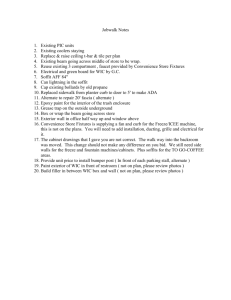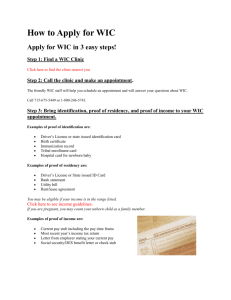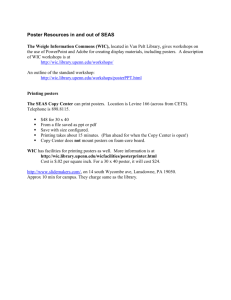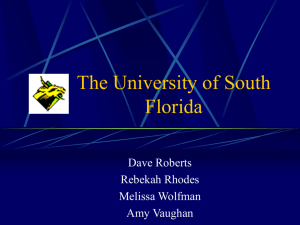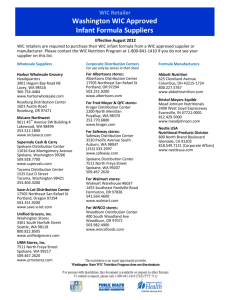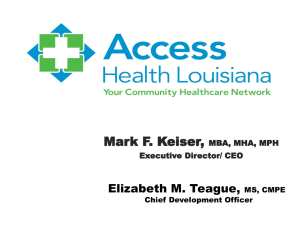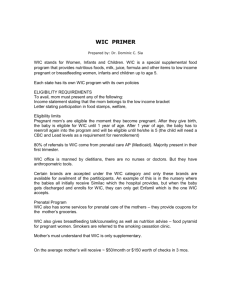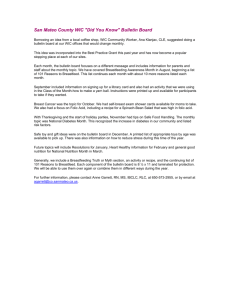Where are we now? - StudentAffairs.com
advertisement
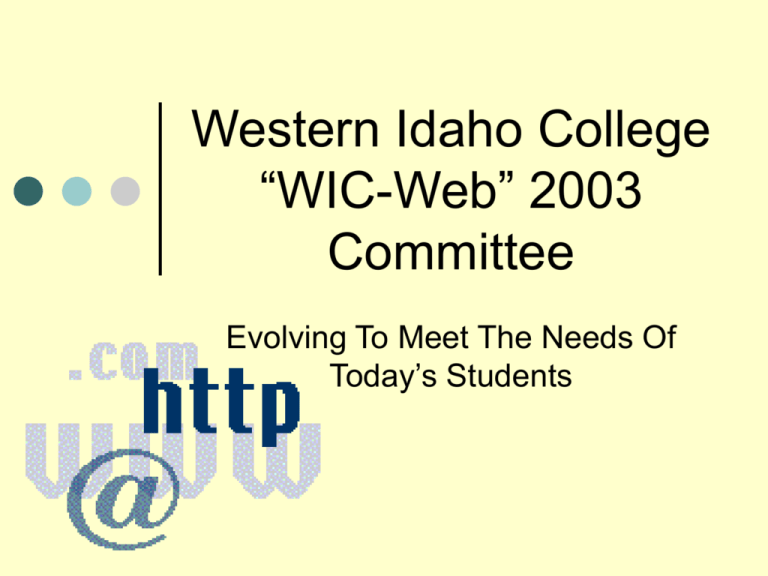
Western Idaho College “WIC-Web” 2003 Committee Evolving To Meet The Needs Of Today’s Students The Story of Spud . . . Spud, a traditional student, is searching online for information on attending colleges in his home state of Idaho. He has visited other college websites and is now perusing Western Idaho College’s (WIC) website to find more information on applying. In addition, he is hoping to find information on student life at WIC. Upon viewing the website, he becomes frustrated as he is unable to find the information he is looking for. After unsuccessfully navigating the site, Spud emails the college to convey his frustration and then decides to move on with his college search at other college websites . . . The Story of Spud cont. The Vice President for Student Affairs, aware of WIC’s IT issues has charged our committee with the task of reviewing and proposing changes to the Student Life Website. Our goals as a committee are to: Define who our students are today Define our institutional website goals and mission Assess current website practices through current research Determine advantages and challenges of incorporating student services online Critique current website Provide committee recommendations Establish outcomes and evaluation processes Who are our students today? Millenials/Net Generation 86% of college students have gone online, compared with 59% of the general population College students are frequently looking for email, with 72% checking their email at least once a day 49% first began using the internet in college; half (47%) first began using it at home before they arrived at college 85% of college students own their own computer, and 66% use at least two email addresses Source: The Internet Goes to College from studentaffairs.com, September 15, 2002 Who is our targeted web audience? Though our larger web audience includes Faculty, Staff, University Administration, Alumni and Friends, our targeted audience consists of Prospective students Current Students What are our student’s web expectations? Students today are able to complete many business transactions online from buying cd’s/dvd’s to renewing their driver’s license. Students want and expect to receive comparable, if not better, service from their educational institution as they receive in their personal lives. Anytime, Anyplace - Younger generation students want to serve themselves and expect services to be available 24 hours a day, seven days a week from any location What are our student’s web expectations? (cont.) Personalized service is expected whereas general services are obsolete. Students want to be recognized as an individual One size no longer fits all. With diverse student populations, students expect institutions to deliver services that are specific to their needs or interests. They also want to choose their own formats, views and preferred services for easy access at their own convenience Interactive – More and more, students expect interactive pages that take them more quickly to the information they seek. Source: Western Interstate Commission for Higher Education (WICHE) http://www.wcet.info/projects/laap/guidelines/overview.htm Who are we as an institution? WIC is . . . A small, public, liberal-arts college An institution that emphasizes liberalarts and sciences, health-related and other professional studies and research What is our goal and mission as an institution? WIC seeks . . . To create a learning environment that empowers and affirms the full development of students To encourage students to develop intellectual, humanitarian, and leadership skills that will advance their potential for service in all areas of human endeavor To provide minority students an academic and social environment for learning, involvement, and leadership development To provide educational programs to meet the needs of adult learners To provide continuing education programs Source: http://studentaffairs.com/vcs/2003vcs/mission.html How do we incorporate our institutional goals and mission into our website? WIC’s website statement of philosophy . . . At Western Idaho College we have taken the charge of creating a website that is here to meet the needs of our current and prospective students, faculty, administration, alumni, and friends. Through our website we hope to: Promotes WIC’s Student Affairs Division as well as the college as a whole, including its initiatives, academic programs, events, faculty, staff, and students Functions as an efficient and effective educational tool, providing access to online courses and other educational resources How do we incorporate our institutional goals and mission into our website? WIC’s website statement of philosophy (cont.) Provides access to information and services for potential and current students while maintaining creativity and flexibility to reach the needs of our webguests Provide prompt answers to any questions our web guests may have regarding our services or information found on the website Facilitate a sense of WIC community through online forums and discussions Serve as a primary source of information about Western Idaho College Where are we now? Assessment of current website practices based on current research . . . Beede and Burnett (1999) are critical of the current state of student affairs in that services are not student-centered nor compatible with the future higher education environment. “Change agents" which are reasons for why different demands are being placed on higher education include: creation of a global economy emergence of the information age which requires high tech skills changing demographics and expectations of students served increased financial pressure driving colleges and universities to become more cost-effective. Where are we now? Assessment of current website practices based on current research (cont). . . Traditional Model of Student Affairs Practice: Functional silos Segregated departments and processes Lack of communication across departments Lines and multiples offices Limited access (8-5 p.m.) Bureaucratic, paper-driven processes Sometimes inconsistent information Redesigned Model of Student Affairs Practice: Cross-Functional teams Integrated systems, organizations and processes Cross-trained teams “One or None” philosophy Anytime and anyplace One source of data, electronic Consistent information, integrated and common interfaces Where are we now? Assessment of current website practices based on current research (cont). . . Improved access to information will result in role changes for personnel (from disseminators and processors of information to planners and delivers of needed services) as well as reduced time for students to conduct businesses transactions with the college/university. The creation of a student-centered environment is required to stay competitive, and requires leaders to "change key paradigms, transform processes, leverage investments in technology, and select technology and process enablers." Source: Beede, M. & Burnett, D. (1999). Planning for Student Services: Best Practices for the 21st Century. Ann Arbor, MI : Society for College and University Planning. Evolution of Web Development As student services move online, may institutions progress through a series of stages of web development. Generation 1 – Content Brochure stage – static printed material transformed into static electronic material Information presented through institution’s point of view Tons of info placed on web Navigation is confusing Keeping information current and accurate is a challenge Evolution of Web Development Generation 2 – Content in Context Information channeled for population segments Separate paths for different types of students (i.e. prospective and current) Still functioning as “silos” Evolution of Web Development Generation 3 – Customization, Personalization and Community More interactive including business transactions “One-stop” services Moving from institution-centric to studentcentric Transaction services, portals, and communication tools enhance student experience Evolution of Web Development Generation 4 – High Tech/High Touch Highly personalized interaction Services designed to establish and nurture a relationship between the student and the institution Student-centric, not institution-centric 1:1 relationship – provides services the student wants and needs Routine services available 24/7 Easily navigable Sources: Beede, M. & Burnett, D. (1999). Planning for Student Services: Best Practices for the 21st Century. Ann Arbor, MI : Society for College and University Planning. Kleeman, G. (2002). Web-Enabled Student Services: Passing Fad or Wave of the Future? http://eastweb.east.asu.edu/garyk/NASPA%20Boston/NASPA%20Boston%20Panel_files/frame. htm WICHE http://www.wcet.info/projects/laap/guidelines/overview.htm So where are we now? Based on our research . . . WIC is functioning through the traditional model of student affairs practice and slowly moving toward the redesigned approach On the stages of web evolution we are still in the Generation 1 – Content Advantages and challenges to incorporating student services online Advantages: Efficiency – eliminates time students must wait in line, student don’t enjoy being “bounced” around campus or online, eliminates paper waste Cost-effective – with state budgets declining, automating routine services and making them more accessible may save money in the long run Retention – students feel connected, students are attracted to campuses with up-to-date technology, students and parents more likely to be satisfied with high level customer service Challenges: Allocation of resources – staff time devoted to web development, long term commitment from staff Training – we cannot assume that faculty and staff know how to use the online services we intend to provide our students. We must adequately train them Improving Communication – we must ensure that staff responds to all inquiries in an efficient and timely manner Advantages and challenges to incorporating student services online Advantages (cont.) Increasing Enrollments – Online forms and services as well as online classes will help accommodate growing enrollments Student expectations – students expect the same level of online service from their educational institution as they receive in their personal lives Access – Services available to all types of students (traditional, part-time, nontraditional, distance learners, prospective students and alumni) Challenges (cont.) Customer service – with the loss of “face-time” with students, we must ensure that any online interactions incorporate strong customer service values Legal Issues – ensuring that all student records and information provided is compliant with the Federal Education Rights and Privacy Act (FERPA) as well as any other applicable state and federal laws Services for the disabled – online courses and services need to be designed, from the start, to be accessible by all students, including those with visual and audio disabilities Critique of current WIC website Information is presented in “brochure” format (i.e. athletic games/scores and policies and procedures) Website presents basic and limited outline of students affairs division Student Life website not connected to WIC’s institutional website Disconnect from all other institution departments and resources - students looking for information related to academics, financial aid and other student services must leave our site altogether. Website is “Institution-centric” – it is designed from WIC’s perspective rather than the student’s perspective Critique of current WIC website (cont.) Website is set up as it is physically designed – separate departments that act as “silos” causing students to “bounce” around to find what they need. Minimal use of current web-design programs, no graphics or pictures Appearance is too informal and not aesthetically pleasing Information is outdated – advertising past events (i.e. “January 15: Residence halls open” and Residential Life link states it will be functional as of Spring 2003, which it isn’t) Obvious lack of updating information by including “This page last updated November 15, 2002” Critique of current WIC website (cont.) Website is not user-friendly and not easy to navigate – The “quicklinks” make no sense as they are duplicated on the sidebar (i.e. “Mission and Program,” “Policies and Procedures” and “Residence Information/Residence Life”) Unprofessional use of language – the word “stuff” used in numerous places throughout the website and inconsistent wording (i.e. “Residence Information/Residence Life”) No personal contact information listed anywhere on site and contact information under “Orientation” gives an extension only. This assumes that students know the telephone prefix, which incoming students most likely would not. Only targets one, limited audience – current students Inactive links cause students to become frustrated and leave the website altogether (i.e. “Career Services” is an inactive link) Committee Recommendations We recommend that WIC’s Student Life Department completely redevelop the current website Understanding that a divisional website is useful to the department, through our research we determined that a comprehensive institutional website that addresses students’ needs from their perspective is more effective. Therefore, we recommend convening a committee comprised of both the academic and student affairs divisions of WIC to redesign the institution’s website including all departments and divisions Committee Recommendations (cont.) We recommend hiring someone with web design expertise who can create a brand identity for WIC and design a modern, aesthetically pleasing and consistent website for the institution. This committee will also work with Western Cooperative Consulting (WCC) to assist us in planning, designing, and developing online student services. http://www.wcet.info/consulting/index.htm Committee Recommendations (cont.) Utilize the Western Cooperative for Educational Telecommunications’ (WCET) guidelines for creating student services online http://www.wcet.info/projects/laap/guidelines/index.htm Create a “One-Stop” shop for students’ needs that combines all student resources in a single location. Utilize the University of Minnesota’s “One-stop” program as a resource http://onestop.umn.edu/Student/index.html Convene WIC Website committee immediately with a goal of having the website up and running by fall 2003. Outcomes and Evaluation Upon completion of the Western Idaho College website, we hypothesize that the website will be more user friendly, interactive, student focused, and easy to navigate. We hope to increase student access, retention, and overall institutional efficiency. We hope to meet the needs of our techsavvy students, encouraging student development while creating a sense of community, utilizing online forums, discussions and web chats. Thank you! The “WIC-Web” 2003 Committee: Marissa Valdez, Moses Davis, Kelly Novitski and Blanca Vega New York University
